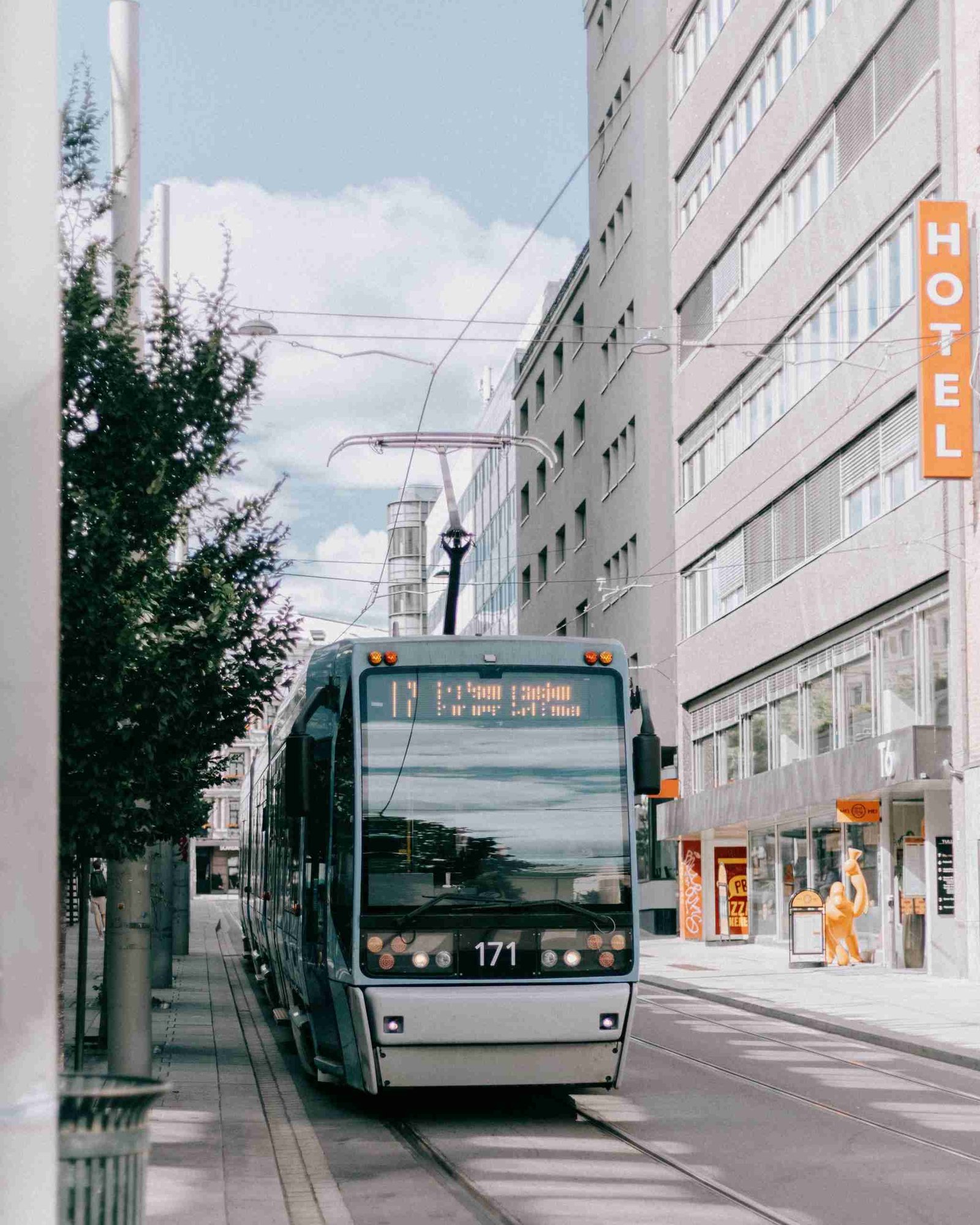
City Layout
Oslo‘s compact size and public transit make it a breeze to get around. The downtown city center is perfect for exploring on foot, and for longer distances, there’s an efficient public transportation system in place, including light rail and metro stations. With its pedestrian-friendly design, getting around Oslo‘s city centre couldn’t be easier. Whether you’re strolling through downtown or hopping on a tram or bus to reach farther destinations, the layout ensures seamless navigation.
Landmarks
From the iconic Royal Palace to the striking Opera House, Oslo is home to an array of captivating landmarks. Visitors can delve into history at Akershus Fortress or immerse themselves in art at Vigeland Sculpture Park. These landmarks not only offer visual splendor but also provide insight into Oslo’s rich cultural heritage.
Districts
Oslo’s diverse districts cater to various interests and preferences. Whether it’s the vibrant atmosphere of Grünerløkka or the upscale allure of Frogner, each district has its unique charm and attractions waiting to be explored. From trendy shops to tranquil parks, delving into different districts guarantees a well-rounded experience of all that Oslo has to offer.
Accessibility
One standout feature of getting around Oslo is its commitment to accessibility for everyone. Public transportation and major attractions are designed with inclusivity in mind, ensuring that individuals with disabilities can navigate the city comfortably and enjoyably.
Public Transport Overview
Types Available
Oslo’s public transportation system offers a diverse range of options, including buses, trams, ferries, the metro, and tickets. Whether travelers are exploring the city center or venturing into the outskirts, these various transport modes cater to different travel needs. For instance, those staying for an extended period might find multi-day passes more cost-effective than single tickets for each journey. By understanding the available ticket types and their suitability based on one’s itinerary, visitors can efficiently plan their travels in Oslo.
Operating Hours
Operating from early morning until late at night, Oslo’s public transit ensures that commuters have access to transportation throughout most of the day with a ticket. However, it is important to note that some services may have reduced operating hours during weekends or holidays. Being aware of these nuances allows travelers to make informed decisions when planning their daily activities and excursions around Oslo.
Ticketing System
The ticketing system in Oslo provides convenient options such as mobile ticketing and travel cards. Single tickets are valid across all modes of public transport within a specified time frame. Familiarizing oneself with this system streamlines the travel experience by enabling quick and hassle-free access to transportation without having to worry about purchasing separate tickets for different modes of transit.
Safety Measures
Passenger safety is paramount in Oslo’s public transport system, with CCTV surveillance and emergency assistance points ensuring a secure environment for commuters. Well-lit stations and trained staff further contribute to creating a safe atmosphere for passengers using public transportation in Oslo. Understanding these safety measures promotes confidence among travelers when utilizing public transport facilities.
Buses and Trams
Major Routes
Oslo’s buses and trams are designed to connect major areas of interest, ensuring efficient exploration. Whether it’s the Royal Palace or the Viking Ship Museum, these public transport options offer seamless connections to popular attractions. By understanding the major routes, travelers can optimize their time in Oslo, making sure they don’t miss out on any must-see spots. For example, tram line 12 takes passengers from the city center to Vigeland Park, a famous sculpture park in Oslo.
Frequency
The public transport services in Oslo boast high frequency throughout the day for buses, trams, and even metros. This means minimal waiting time for commuters as they navigate through the city. Travelers can rely on these frequent services for convenient and stress-free city navigation. With such regular intervals of service, visitors can easily plan their itinerary without worrying about long waits at stops or stations.
Night Services
For those exploring Oslo after dark, night buses and trams become essential transportation options covering key routes across the city during late hours. These accessible night services enhance convenience for evening activities by ensuring that travelers have reliable transportation options even when most other modes of transport have ceased operations.
Oslo Metro (T-Bane)
Lines and Stations
Oslo’s metro system consists of multiple lines, tram routes, and bus services. The strategically placed stations cater to both popular tourist attractions and residential areas. Familiarizing oneself with the various lines and stations is crucial for efficient travel planning in Oslo. For instance, the Grønland station is located close to the city center, making it convenient for accessing cultural landmarks like the Munch Museum or exploring local markets.
Travel Times
Understanding different travel times between destinations within Oslo is essential as they vary based on the mode of transportation chosen and the specific route taken. For example, traveling from Majorstuen station to Jernbanetorget can take around 10 minutes by metro but may require a longer duration if using a combination of tram and bus services due to varying traffic conditions. This knowledge enables visitors to create realistic itineraries while exploring Oslo without underestimating travel durations.
Connecting Services
The metro system in Oslo seamlessly connects with other modes of public transport such as trams and buses at key interchange points. Understanding these connecting services allows travelers to plan their journeys more effectively by utilizing different modes of transport for optimal convenience and efficiency.
Fjord Routes
In addition to its land-based network, Oslo’s public transport also includes ferry routes that navigate through its stunning fjords. These scenic waterways offer an alternative means of getting around while providing breathtaking views of Norway‘s picturesque landscapes.
Ferries and Water Taxis
Fjord Routes
Ferries and water taxis offer a unique way to explore the city. The fjord routes provide convenient access to popular attractions such as the Oslo Opera House, the Viking Ship Museum, and Bygdøy Peninsula. These routes not only serve as a means of transportation but also offer an opportunity to enjoy breathtaking views of the city from the water.
The ferries operate on regular schedules, making it easy for visitors to plan their trips effectively. For instance, during peak seasons, there are increased departures, ensuring that travelers can easily hop on a ferry without long wait times. This reliability makes it convenient for tourists looking to optimize their time in Oslo by visiting multiple destinations in one day.
Scenic Views
One of the major highlights of using ferries or water taxis is the opportunity to experience scenic views of Oslo’s coastline and surrounding islands. Travelers can admire picturesque landscapes while cruising through tranquil waters, creating unforgettable memories during their visit. These vessels often have outdoor decks where passengers can soak up the sun and capture stunning photographs against Oslo’s iconic skyline.
For those who prefer more flexibility in their exploration, there are various rental options available for private boat tours or charters. This allows visitors to customize their itinerary based on personal preferences and enjoy a more intimate experience with friends or family members while navigating through Oslo’s waterways.
Biking in Oslo
Rental Options
There are several rental options available throughout the city. Many companies offer bike rentals at affordable prices, typically ranging from 100 NOK to 300 NOK per day. Visitors can easily find rental shops near popular attractions and transportation hubs.
For example, Oslo City Bike provides a convenient option for short-term use with multiple docking stations across the city. Tourists and locals alike can access these bikes using a mobile app or at any station, making it an efficient choice for exploring the city.
Bike Lanes
Oslo’s extensive network of bike lanes makes cycling a safe and enjoyable experience for riders of all skill levels. The city is committed to promoting sustainable transportation, evident in its well-maintained lanes that stretch across major roads and scenic routes.
Cyclists can traverse iconic landmarks such as the Akershus Fortress or enjoy picturesque waterfront views along dedicated paths. With over 200 kilometers of bike lanes, navigating through Oslo becomes seamless while admiring its natural beauty.
Rules and Tips
Understanding the rules and tips for cycling in Oslo is essential for a smooth experience. Cyclists must adhere to traffic signals, yield to pedestrians on shared pathways, and use hand signals when turning or changing lanes. Wearing a helmet is not mandatory but highly recommended for safety.
Moreover, visitors should familiarize themselves with local biking etiquette to ensure harmony among cyclists and pedestrians sharing common areas like parks or promenades.
Walking Around Oslo
Pedestrian Zones
Oslo is a city that offers plenty of pedestrian-friendly zones, making it an ideal place for exploring on foot. The city center and waterfront areas are particularly well-suited for walking, with wide sidewalks and pedestrian-only streets. Tourists can stroll along Karl Johans Gate, the main street in Oslo, which is closed to traffic and lined with shops, cafes, and historical landmarks.
For instance, Aker Brygge is a popular area where visitors can enjoy a leisurely walk along the harbor promenade while taking in stunning views of the fjord. Areas like Grunerlokka offer charming streets filled with unique boutiques and cozy cafes perfect for wandering around.
Walking Tours
To delve deeper into the city’s history and culture while getting some exercise at the same time, tourists can opt for guided walking tours. These tours provide insightful commentary from knowledgeable guides as they lead participants through various neighborhoods and attractions.
For example: Viking Biking offers themed walking tours such as “The Essential Oslo Walk” which covers major sights like Akershus Fortress and City Hall Square. This allows visitors to gain valuable insights into Oslo’s rich heritage while enjoying a scenic stroll through its picturesque landscapes.
The Oslo Pass Benefits
The Oslo Pass offers a range of benefits that make it an excellent choice for travelers exploring the city. One of the key advantages is the provision of free transport, which includes access to buses, trams, ferries, and local trains within zones 1 and 2. This makes it incredibly convenient for visitors to move around without incurring additional transportation costs.
In addition to free transport, the Oslo Pass also provides holders with a variety of additional perks such as free entry to over 30 museums and attractions, discounts on sightseeing tours, dining experiences, and shopping. These additional benefits not only enhance the overall travel experience but also help visitors save money during their trip.
Travelers have the option to choose between a 24-hour pass or a 48-hour pass based on their duration of stay in Oslo. This flexibility allows them to select a pass that aligns with their specific travel plans and maximizes cost-effectiveness. Moreover, the inclusion of off-peak travel further adds value by enabling pass holders to enjoy discounted fares during non-peak hours when exploring different parts of Oslo.
Practical Tips for Tourists
Off-Peak Travel
When getting around Oslo, consider traveling during off-peak hours to avoid the rush and save on transportation costs. The city’s public transport system, including buses, trams, metro, and ferries, can get crowded during peak times. By adjusting your travel schedule to off-peak hours, you’ll have a more comfortable journey and potentially lower fares.
Opting for off-peak travel also allows visitors to explore popular attractions with fewer crowds. For example, visiting the iconic Vigeland Sculpture Park or the Viking Ship Museum during quieter periods enhances the overall experience by providing a more serene atmosphere for sightseeing and taking photographs.
Apps and Maps
Utilizing navigation apps and maps is essential for tourists navigating Oslo. There are several user-friendly mobile applications available that provide real-time information on public transport schedules, routes, ticket purchasing options, as well as walking directions in the city. These apps not only help travelers plan their journeys efficiently but also offer valuable insights into nearby points of interest.
In addition to digital tools, obtaining physical maps from visitor centers or hotels can be beneficial when exploring Oslo. Having a paper map as a backup ensures that visitors can navigate even in areas with poor network coverage or battery issues. Furthermore, these traditional maps often include additional details about historical sites or hidden gems that might not be featured on digital platforms.
Language Tips
For international tourists, it’s helpful to learn some basic Norwegian phrases before visiting Oslo. While many locals speak English fluently, making an effort to greet in Norwegian or asking for directions in the local language can enhance cultural exchange experiences and make interactions more enjoyable for both parties.
Frequently Asked Questions
How can I navigate Oslo’s landscape efficiently?
To navigate Oslo’s landscape efficiently, utilize the city’s extensive public transportation system, including buses, trams, the metro (T-Bane), and ferries. Consider using a bike or walking for shorter distances to explore the city at a leisurely pace.
What are the benefits of using the Oslo Pass?
The Oslo Pass offers free entry to many museums and attractions, unlimited travel on public transport within zones 1 and 2, as well as various discounts on sightseeing tours, dining options, and more. It provides a convenient and cost-effective way to explore Oslo.
Is biking a popular means of getting around in Oslo?
Yes! Biking is incredibly popular in Oslo due to its well-maintained cycling infrastructure and numerous scenic routes. The city’s compact size makes it ideal for exploring by bike while enjoying beautiful views along the way.
What practical tips should tourists keep in mind when getting around Oslo?
Tourists should consider obtaining an Oslo Pass for convenience and savings. Familiarize yourself with public transport schedules, especially if you plan to use buses or trams. Be mindful of pedestrian-friendly areas when walking around the city.
Are there any unique ways to experience transportation in Oslo?
Absolutely! In addition to traditional modes of transportation like buses and trams, visitors can enjoy exploring by ferry or water taxi – offering a memorable perspective of this vibrant coastal cityscape.



